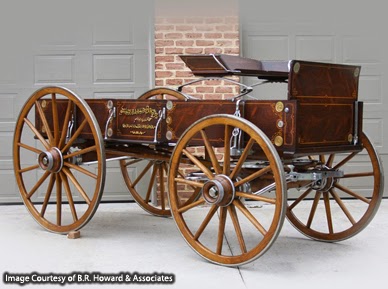Whether we’re talking about human natureand our tendency to be creatures of habit or the fact that comparable ideas aresometimes reborn in different packages, history does indeed have a way ofrepeating itself. A few years ago, Iwrote about the twin axle steering system that was offered in some Chevytrucks. The basic idea is one that hadbeen around for quite a while. In fact,the wood-wheeled wagon industry had generated multiple patents on the concept atleast 140 years ago.
Similarly, the use of aluminum in workvehicles is not a new notion. With thatin mind, most readers are likely aware that the 2015 Ford F150 trucks havereceived a lot of press for using an aluminum-alloy versus steel in the newtruck bodies. While the switchover leftmany with reservations, this 21st century announcement is far fromthe first time a well-known vehicle brand engaged the properties of aluminum insteadof relying on heavier metalwork. In 1893,the legendary Studebaker Bros. Manufacturing Company demonstrated a level ofsuperior craftsmanship as well as innovative thinking by creating a first-of-its-kindwagon utilizing aluminum in place of all of the vehicle metal – except for thesteel tires. The wagon was initiallyunveiled at the Columbian Exposition (Chicago World’s Fair) that year.
 |
| This 1893 wagon was especially built with aluminum hardware and structural supportsto showcase Studebaker craftsmanship and innovation. |
Eleven years later, Studebaker againdisplayed the well-known aluminum wagon at the 1904 World’s Fair in St.Louis. At this huge, internationallyrecognized event, Studebaker had one of the largest carriage and wagon displayswith 75 different vehicles exhibited. Among those pieces were exquisite broughams, victorias, depot wagons,coupe rockaways, extension and canopy top surreys, phaetons, top buggies,runabouts, road wagons, farm wagons, coal wagons, express and truck wagons,sheep camp wagons, mountain wagons, and electric as well as gasoline poweredautos.
Perhaps the most extraordinary vehiclein the group was the “Aluminum Wagon.” At the time, this precious metal was quite expensive and working itrequired exceptional skill levels. TheAugust 1904 issue of “The Carriage Monthly” carried a detailed description ofthe wagon...
“This metal isadaptable to mechanical and manufacturing purposes by reason of its extremelightness, great malleability, tensile strength, beauty, and freedom fromoxidation or loss of luster by exposure to the weather.
It required 149pounds and 2 ounces of the new metal to fit up the wagon, whereas if iron hadbeen used the quantity required would have been three times as great or 447pounds. All the metal comprising bolts,nuts, screws, rods, clips, braces, chains, nails, etc. are made from solidaluminum. Steel tires are burnished andplated and glisten like a mirror. Thefeat of using aluminum has never been attempted before, and has not beenimitated since the wagon has been built. The accomplishment of such a work as the Studebaker Bros. Mfg. Co., willbe appreciated by mechanical experts as an achievement of no ordinarycharacter. The aggregate labor in makingand finishing the wagon represented an expenditure of four hundred andtwenty-four and one-half days, at a total cost for the wagon of $2,110.68.
The box or bodyhas a remarkable history. It is made ofrosewood, inlaid with a border of holly, and the 35 medals awarded to thecompany since 1852. The inscription ofthe box is in raised gold letters. Therosewood log weighed 1,505 pounds and cost $230.80. It had to be large enough to cut out box,sides, and ends to suit. This log wascut in the province of Belmonte, Brazil and was brought down the Belmonte Riverfor a long distance in huge canoes, thence by barge to Bahia, Brazil and thenceto New York by steamer. The Astoria VeneerMills, of New York, the importing firm, state that it was by the greatest goodfortune that the log was secured, and the probabilities are that years willelapse before another one like it will appear in the market. It required the services of a woodworkerthree months to prepare the wood for the finisher, and 36 different processeswere gone through to bring it to its present state of finish and polish.
The usualstriping and corner scrolls are imitated with white holly, all inlaid intomahogany, and the name of the firm is in solid gold raised letters, in the shapeof a graceful ribbon pattern placed in the center of the side panels of thebox.”
Clearly, this vehicle was (and remains)a head-turner. Several years ago, Iwrote a brief piece on Studebaker’s Aluminum Wagon. One of the bestparts of this story is that the wagon still exists. If you’re ever in South Bend, Indiana, you’llwant to make plans to stop by the Studebaker National Museum and see this amazing part of America’s transportationhistory. It’s in remarkable condition. In fact, a few years ago, the wagon underwentprofessional cleaning and conservation work by B. R. Howard and Associates in Carlisle, Pennsylvania. Brian and his team did an exceptional jobbringing back the highly polished look and rich wood tones. Our thanks to them for sharing these photoswith us.
Thanks for stopping by today. By the way, if you haven’t signed up to receive this weekly blog via e-mail, just type your address in the "Follow By E-mail" section above. You'll receive a confirmation e-mail that you'll need to verify before you're officially on board. Once that's done, you'll receive an email every time we update the blog. Please don't hesitate to let us know if we can be of assistance. We appreciate your continued feedback and look forward to sharing even more wooden vehicle info in the coming weeks.
Please Note: As with each of our blog writings, all imagery and text is copyrighted with All Rights Reserved. The material may not be broadcast, published, rewritten, or redistributed without prior written permission from David E. Sneed, Wheels That Won The West® Archives.

